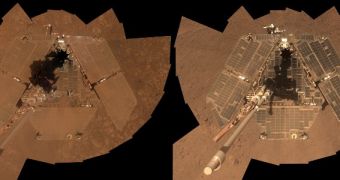Mission controllers at the NASA Jet Propulsion Laboratory (JPL) in Pasadena, California, have said recently that the Mars Exploration Rover (MER) Opportunity now has cleaner solar panels than in any other winter it has spent on the surface of the Red Planet. This is a critically important aspect of operating the solar-powered rover, which has no other energy source.
Its newer counterpart on Mars, the Mars Science Laboratory (MSL) rover Curiosity, is powered by a nuclear engine, which is impervious to the amount of dust present in the atmosphere. However, during the winter, Opportunity needs to gather as much sunlight as possible during the day. For the 10-year-old rover, this is its sixth Martian winter. The robot was originally supposed to endure for just 3 months.
Opportunity endured its first Martian winter in 2005, and four more have passed since. During each winter, the amount of dust on its solar panels gave JPL engineers headaches. The problem is pervasive even during the summer, and only the occasional gust of wind cleans up the collecting surface. In the image above, you can easily compare what the solar panels looked like in March (right) versus January, 2014.
The extra energy the rover is now getting is being used to investigate an outcrop called Murray Ridge, which lies on the western rim of Endeavour Crater. The purpose of these studies is to analyze whether or not an ancient wet environment existed on our neighboring world that might have supported the development of even basic life forms.

 14 DAY TRIAL //
14 DAY TRIAL //